Many Americans are working, but poor. Along with low wages and few benefits, the working poor frequently find themselves up against erratic work schedules, with hours and shifts that change day-to-day and week-to-week with little advance notice. Particularly in the food-service and retail sectors, which employ 17% of American workers, such unstable and unpredictable work schedules are widespread.1 Now, newly available data from The Shift Project offers unprecedented insight into the prevalence of unstable work scheduling conditions and the consequences of this instability for workers and their children.
Among 30,000 employees at 120 of the largest retail and food-service firms in the United States, the large majority of workers have little advance notice of their schedules: two-thirds have less than two weeks’ notice, and half of those get less than a week’s notice (Figure 1). Workers’ schedules are also often changed at the last minute, with 14% reporting at least one cancelled shift in the last month and 70% reporting at least one change to the timing of one of their shifts in the past month. Many workers are expected to work on-call shifts (25%) and back-to-back closing-then-opening shifts separated by less than 11 hours (“clopenings”) (50%).
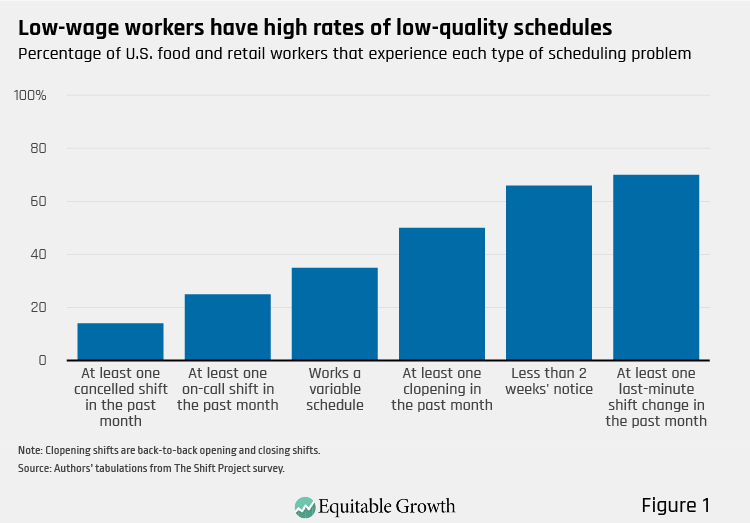
From the perspective of workers, this is not desirable schedule flexibility, but rather unpredictability and instability imposed by employers, often with the aid of workforce management technology and algorithms. We find that 80% of workers have little to no input into their schedules and that 69% are required by their employer to keep their schedules “open and available” to work whenever needed. Asked if they would like a more stable and predictable schedule, 75% of workers say that they would (Figure 2). This precarious scheduling occurs against a backdrop of insufficient work hours. We find that a third of workers are involuntarily working part-time: They usually work fewer than 35 hours and would like to be scheduled for more hours at their job.
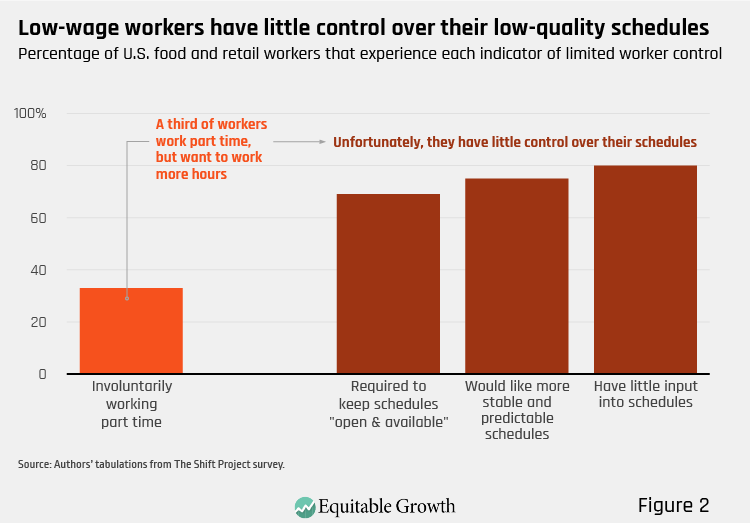
Unpredictable and unstable work schedules in retail and food service are common, but they are not universal. Within these sectors, there is variation in the degree to which employees are exposed to precarious scheduling. We take advantage of this variation, comparing workers exposed to unstable and unpredictable schedules at work to otherwise similar workers in similar jobs who have a greater degree of stability. These comparisons reveal the widespread negative consequences of unstable and unpredictable schedules for workers and their families.
- We show that while exposure to just-in-time scheduling is high for all groups of workers, it is also fundamentally unequal, as workers of color, and particularly women of color, are exposed to the most unstable and unpredictable work scheduling practices.
- We show how exposure to unstable and unpredictable scheduling practices gives rise to household economic insecurity and dramatic increases in hunger and other hardships.
- We show how parental exposure to unstable work schedules has intergenerational consequences, by creating instability in children’s routines and care arrangements and also manifesting in children’s heightened anxiety and acting out.
- We show that the day-to-day instability of schedules within jobs is inextricably linked to job instability, leading to turnover for workers that imposes costs on individuals and on firms.
These findings are reported in a set of five working papers, released as part of the Washington Center for Equitable Growth working paper series. This report shares highlights from these five papers.
Racial/Ethnic Inequality in Work Scheduling
Pervasive and persistent racial and ethnic inequalities in the American labor market in hiring, wages, and fringe benefits packages are well-documented in research.2 But, far less is known about racial inequality in work schedules.3 Yet, whereas wage and benefit levels are often regularized by tenure or job grade within organizations, front-line managers have a great deal of discretion in work scheduling, raising the risk that managers’ conscious or unconscious racial biases could produce racial and ethnic inequality in scheduling.4
Black and Latinx workers are over-represented in the retail and food-service sectors, where work schedule instability is prevalent.5 We also find evidence of substantial racial and ethnic inequality in work scheduling among workers in retail and food service. For instance, while 13% of white workers report at least one cancelled shift in the last month, the share is 30% higher, at 17%, for non-white workers. We see this same pattern across a range of indicators of unstable work schedules: non-white workers are 10% to 20% more likely to experience on-call shifts, clopenings (back-to-back closing-then-opening shifts separated by less than 11 hours), and involuntary part-time work.
Overall, when we consider all measures of schedule instability together, we see large racial inequalities in work schedules, represented by the blue bars in Figure 3. Exposure to schedule instability is 16% higher among non-white workers compared with white workers. This gap is largest, though, for women of color, at 18% (vs. 12% among men), and the gap between white and Latinx workers, at 17%, is somewhat larger than the gap between white and Black workers (14%).
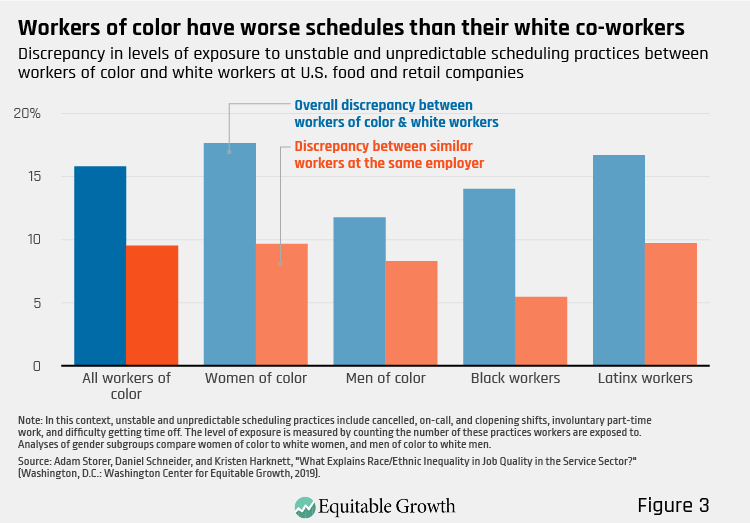
In fact, even when we compare among workers with the same demographics and the same educational attainment who work at the exact same companies, we find that workers of color still have more unstable and unpredictable work schedules (Figure 3, orange bars). Even when comparing white and non-white workers with similar characteristics within the exact same firms, a 5% to 10% gap in exposure to precarious scheduling remains.
The remaining race gap could come about if managerial discretion in assigning schedules gives rise to discriminatory treatment. If managers’ conscious or unconscious racial bias affects work schedule allocations, then non-white workers could be at a severe disadvantage. While 80% of white hourly workers report that their direct supervisor is also white, only 38% of non-white hourly workers report that their direct supervisor is of their same race. It turns out that having a manager of a different race accounts for 25% of the remaining scheduling gap between white workers and workers of color and 63% of the remaining gap between Black and white workers.
Economic Consequences of Precarious Schedules
Over the past thirty years, prominent politicians and policy makers have argued that the surest route out of poverty is employment. Yet, recent analyses show that millions of workers in America are impoverished and at least a third of households with a working adult experience material hardship—such as not being able to afford enough to eat, stable housing, or needed medical care.6
Measures of Material Hardships
- You received free food or meals because you did not have enough money.
- You went hungry because you couldn’t afford to eat.
- You borrowed money from friends or family to help pay the bills.
- You did not pay the full balance of your gas, oil, or electricity bill because you did not have enough money.
- You moved in with other people (even for a little while) because of financial problems.
- You stayed in a shelter, abandoned building, automobile, or any other place not meant for regular housing, even for one night.
- Someone in your household needed medical care, but did not visit a doctor or go to the hospital because of the cost.
While a job with a living wage, good benefits, and a stable schedule might indeed provide economic security, jobs in the United States have become more and more precarious in terms of wages and benefits, but also very much in terms of unstable and unpredictable work scheduling practices.7 Such scheduling practices could lead to material hardship by causing income volatility, interfering with public benefits eligibility, over-burdening informal support networks, and even making it difficult to plan for the future.8
We find that material hardship is common among hourly workers at the nation’s largest retail and food-service firms. Overall, six in ten hourly workers experienced at least one material hardship over the prior year. A third of workers reported hunger hardship—that is, a third reported at least one time over the past year when they went hungry and/or relied on free food (such as from a soup kitchen or food pantry) because they couldn’t afford to buy enough food. One in six workers experienced a housing hardship—staying with other people because of housing problems and/or staying in a shelter, abandoned building, or other non-regular housing.
But, comparing among workers with the same wages, workers who had more unstable and unpredictable work schedules were at even higher risk of material hardship. For example, 42% of workers who had shifts cancelled reported hunger hardship as compared with 29% of workers who did not have cancelled shifts (Figure 4). Short notice of work schedules was also associated with hunger: 36% of workers with less than three days of advance notice experienced hunger hardship, compared with 28% of those with at least two weeks’ advance notice. On-call shifts and last-minute changes to schedule timing similarly raised the risk of hunger hardship, of residential hardship, and of any hardship (Figure 5).
Insufficient and volatile work hours also matter. Workers who don’t get enough work hours experience more hunger hardship and more hardship overall. But, it is not just insufficiency, but also volatility that matters. We calculate the degree to which work hours are volatile—that is, vary from week-to-week—by comparing the number of work hours in the week in the last month when a worker had the most hours against the week when they had the fewest. A worker whose lowest week was 20 hours and highest week was 30 hours would have 33% variation in hours—the average for our sample. Compared to workers with steady hours, workers at the 75th percentile for instability (a 50% swing in hours), had a 13% higher risk of hunger hardship and an 11% higher risk of residential hardship.
Employment is no guarantee of economic security, as many American workers are employed yet still experience serious material hardships. Notably, material hardship varied in proportion to the amount of temporal precarity workers experienced from their jobs.
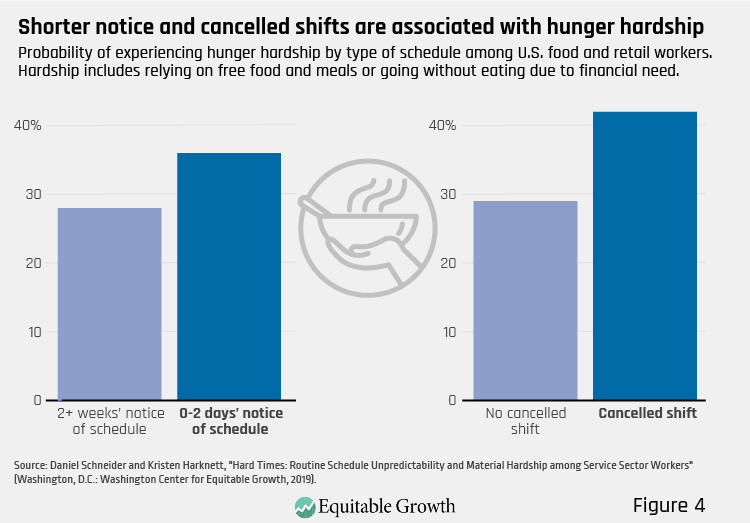
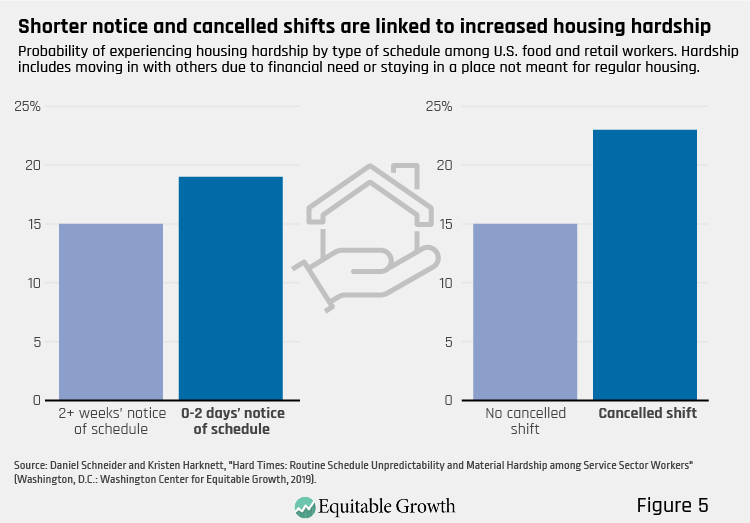
Consequences of Precarious Schedules for Children
If one vision of the retail and food-service workforce is of teenagers starting out and working their first job on their way up the career ladder, the reality is starkly different. Over 70% of retail and food-service workers are over the age of 25, and 1 in 10 American children has a parent working in the sector.9 That matters because the costs of precarious work may not simply be fleeting in the life course or even confined to a single generation. Instead, when parents work unstable and unpredictable work schedules, their children may also be affected.
The foundations for how we fare later in life—in school, in work, in upward mobility—are laid early in childhood.10 Schools and neighborhoods have important effects on child development, but for young children, the family is a formative setting and one that is significantly affected by parents’ job quality.11 The instability and unpredictability that parents experience in their work schedules may spill over at home and negatively affect children by undermining household economic security, upsetting family routines and developmental child care time, and introducing strain and stress into everyday interactions that would ideally be warm and supportive.12 Ultimately, unstable and unpredictable work schedules may reduce intergenerational mobility by constraining children’s opportunities from the start. We trace how parental exposure to unstable and unpredictable work schedules may spill over to affect children in two domains.
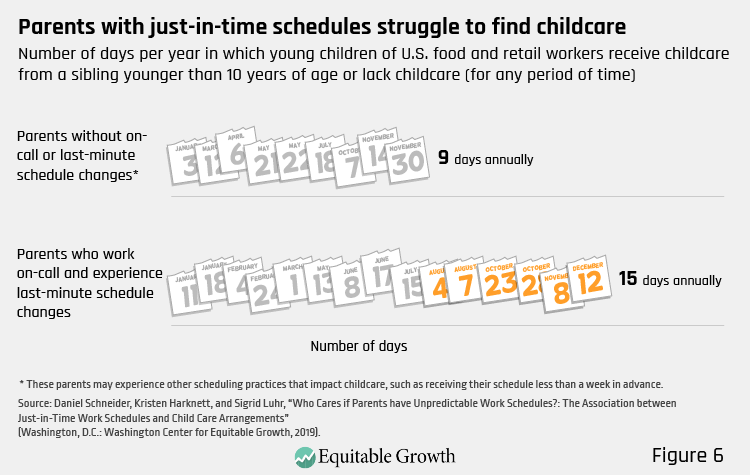
Consistent and quality childcare is essential for healthy child development. But, unstable and unpredictable schedules impose a degree of chaos on parents’ lives that inevitably spill over to their children’s care arrangements. We find that parents’ exposure to on-call work and last-minute shift changes are associated with a reliance on informal care arrangements. In particular, we find that when parents work on-call shifts or have last-minute changes to their schedules, they are more likely to ask siblings to provide care for their younger brothers and sisters (Figure 6). Many of these siblings are children themselves, with parents having even to rely on children younger than age 10 for childcare when the alternative is missing the chance for needed income or even risking their job by missing work.
Kids thrive in environments of security, consistency, and support. These environments are difficult to maintain in the face of on-call shifts, last minute cancellations, changes to schedule timing, and clopening shifts. We find that there is significantly more household economic insecurity in families with young children when parents work more unstable and unpredictable work schedules. We also find that parents have much less time for developmental activities with children, such as reading a book together or having a family meal, when their schedules are unstable and unpredictable. Parents’ wellbeing also suffers: they sleep less well, are more psychologically distressed, and are less happy when working unstable and unpredictable work schedules—a relationship that we’ve documented for all workers, not just parents.13 The weight of household economic insecurity, parental stress, and disrupted family routines imposed by unstable and unpredictable work schedules ultimately depresses child wellbeing.
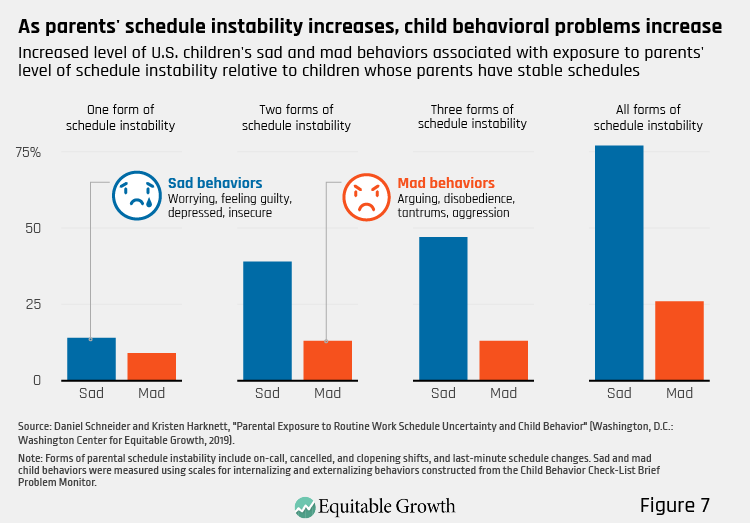
Children whose parents work more unstable and unpredictable schedules suffer (Figure 7). One yardstick for the costs of a parent working an unstable and unpredictable schedule is that their children show more “internalizing” or sad behaviors—feeling worthless, anxious, guilty, self-conscious, unhappy, or worried. We find that children whose parents work on-call, have cancelled shifts, timing changes, or work clopenings score significantly higher on this measure. Another yardstick is that children show more “externalizing” or mad behaviors—arguing, destroying things, being disobedient, stubborn, having temper tantrums, or making threats. Here, the impact of on-call shifts, cancellations, timing changes, and clopenings is smaller, but still significant, elevating these externalizing behaviors as well.
Consequences of Precarious Schedules for Job Turnover
Unstable and unpredictable work schedules don’t just shape life for workers and their families in the moment. These precarious scheduling practices also set workers’ career trajectories. We find that precarious scheduling, including short advance notice and on-call shifts, significantly increases job turnover.
Retail and food service are known to be short-tenure and high-turnover industries. Our data confirm this. We find a six-month turnover rate of 28%. We also find that workers who had unstable and unpredictable work schedules have significantly higher turnover rates (Figure 8). For example, 35% of those who had at least one on-call shift and 42% of those who had at least one cancelled shift in the month prior to first being surveyed were no longer at their job six months later. While the turnover rate was 24% for workers with at least two weeks’ advance notice of their schedules, it was 39% for those with less than 72 hours advance notice.
Having an unstable and unpredictable work schedule leads to turnover because precarious schedules make it untenable for workers to meet their personal needs and care for their families. Workers with precarious schedules also leave their jobs because they feel unfairly treated by their managers and dissatisfied with their jobs. In turn, job loss has well-documented negative effects on future earnings and employment, as well as on psychological wellbeing and health.14
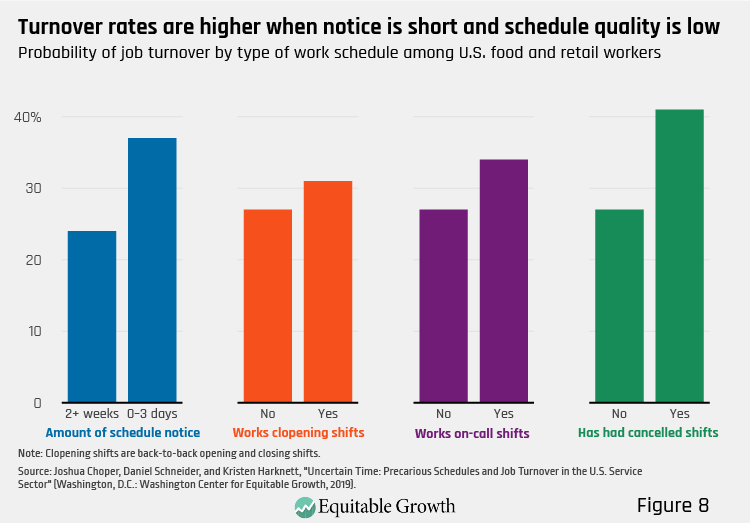
Conclusion
The Shift Project provides a valuable new resource for understanding how the time dimension of job quality—predictability and stability in work schedules—affects the livelihoods and lives of low-wage workers in America. The Shift Project details the routine instability that workers in retail and food service face, and the host of consequences that follow from this instability. The retail and food service sectors now employ 17% of workers in the United States, nearly twice as many as work in the manufacturing sector.15 Work schedule instability and its consequences, therefore, deeply affect a large swath of American families. Unstable work schedules assigned with little advanced notice exact a toll on workers and their children.
With new data from The Shift Project, we can now document a set of downstream consequences of unpredictable and unstable work schedules. Our research sheds light on the human costs when impersonal algorithms determine work schedules or when companies lose sight of the basic needs that all workers have for rest, for advance notice to allow for planning, and for some semblance of regularity in routines. Schedules have a pervasive influence on economic security, the ability to fulfill care obligations, and parents’ and children’s wellbeing. Routinely unpredictable and unstable schedules have predictable and stark consequences: elevating hunger and other material hardships, destabilizing children’s routines and care arrangements, and increasing children’s anxiety and tendency to act out. We also show that workers with unstable schedules experience higher rates of turnover, and such job loss has well-documented negative effects on household finances, psychological wellbeing, and health.16
Unstable schedules are an unrecognized contributor to racial inequality in the United States. People of color are overrepresented in retail and food services, and are therefore disproportionately affected by the widespread instability in that sector. Beyond that, even when we look within the very same employers and in the same types of jobs, workers of color are assigned more unstable work schedules. Given all of the linkages between these schedules and hardships and daily instability for workers and their families, work schedules need to be recognized as one driving force perpetuating racial inequality.
Collectively, these five papers from The Shift Project all point in the same direction: emphasizing the critical role that the temporal dimension of low-wage work—the predictability and stability of work schedules—plays in the lives of American workers. Awareness of the importance of work schedules has begun to grow. A limited set of companies have voluntarily offered more advance notice or announced they will refrain from practices such as on-call schedules, and a set of cities, including San Francisco, Seattle, New York City, Chicago, and Philadelphia, along with the state of Oregon, have passed laws attempting to increase the stability and predictability of work schedules. These companies and localities will demonstrate whether voluntary action or labor laws can move the needle on reducing routine instability in low-wage work. If they do, our research suggests that a large share of American workers and their children will benefit, and that workers of color stand to gain the most.
Read the papers
Endnotes
1 On size of workforce, see Bureau of Labor Statistics, “Labor Force Statistics from the Current Population Survey, Household Data, Annual Averages, 18b. Employed Persons by Detailed Industry and Age.” https://www.bls.gov/cps/cpsaat18b.htm
2 On disparities in hiring, see Quillian et al., 2018; Pager and Shepherd, 2008; Pager, 2003; Pager, Western, and Bonikowski, 2009; Bertrand and Mullainathan, 2004. On gaps in pay, see Mandel and Semyonov, 2016; Cancio et al., 2005; Kalleberg, Reskin, and Hudson, 2000. On benefits gaps, see Kristal et al., 2018; Semyonov et al., 2011; Kalleberg et al., 2000; Hersch and White-Means, 1993.
3 Important exceptions are Swangberg et al., 2014; Reutshlin and Asanta-Muhammad, 2015; Lambert et al., 2014; and McCrate et al., 2012. However, these studies use a very limited set of measures of scheduling and do not decompose the racial and ethnic gaps.
4 On managerial discretion in assigning work schedules, see Lambert, 2008; Wood, 2018.
5 Authors’ calculations from the 2016 and 2017 American Community Surveys.
6 On the working poor, see BLS, 2016. On hardship among working families, see Karpman et al., 2018.
7 On increasingly precarious employment, see Kalleberg, 2011; Kalleberg, 2009; Fligstein and Shin, 2004.
8 On schedules causing income volatility, see Hannagan and Morduch 2015; Murdoch and Siwicki, 2017; Farrell and Grieg 2016; Federal Reserve 2016; Schneider and Harknett, 2017; and on income volatility leading to hardship, see Bania and Leete, 2007; Federal Reserve, 2016; Leete and Bania, 2010; McCarthy et al., 2018; and Finnigan and Meagher, 2018. On schedules interfering with public benefits eligibility, see Hill and Ybarra, 2014; Karpman et al., 2019; and on lack of benefits leading to hardship, see Pilkauskas et al., 2012; Mykerezi and Mills, 2010. On schedules over-burdening informal support networks, see Carrillo et al., 2017; Scott, London, and Hurst, 2005; Henly and Lyons, 2000; and on lack of support leading to hardship, see Edin and Lein, 1997; Harknett 2006; Henly, Danziger and Offer 2005. On schedules making it difficult to plan for the future, see Mullainathan and Shafir, 2013; Shah, Shafir, and Mullainathan, 2015; and on difficulty planning leading to hardship, see Gennetian and Shafir, 2015.
9 On age composition of workforce, see Bureau of Labor Statistics, “Labor Force Statistics from the Current Population Survey, Household Data, Annual Averages, 18b. Employed Persons by Detailed Industry and Age.” https://www.bls.gov/cps/cpsaat18b.htm. Share of children with parent in industry is based on authors’ tabulations from the American Community Survey.
10 On early life foundations, see Bronfenbrenner, 1979; 1986; Heckman, 2006.
11 On the importance of family setting, see Duncan and Murnane, 2011; McLanahan, 2004; Bronfenbrenner, 2005; and Waldfogel and Washbrook, 2011.
12 On schedules introducing economic insecurity, see Federal Reserve, 2016; Golden, 2015, Haley-Lock, 2011; Zeytinoglu et al., 2004; Edin and Schaefer, 2015; and on economic insecurity affecting child wellbeing, see Leininger and Kalil, 2014; Brooks-Gunn and Duncan, 1997; Duncan and Brooks-Gunn, 1997. On schedules affecting time-based conflicts, see Lambert and Henly, 2014; Han and Waldfogel, 2007; Hsueh and Yoskikawa, 2007; and on time-based conflicts affecting child wellbeing, see Conger and Donnellan, 2007; Bodovski and Farkas, 2010; Greeman and Bodovski, 2011; Del Boca et al., 2012. On schedules affecting parental wellbeing, see Zeytinoglui et al., 2004; Schneider and Harknett, 2019; Williams et al., 2019; and on parental wellbeing affecting child wellbeing, see Conger and Elder, 1994.
13 See Schneider and Harknett, 2019.
14 On effects of job loss, see Brand, 2016.
15 On size of workforce, see Bureau of Labor Statistics, “Labor Force Statistics from the Current Population Survey, Household Data, Annual Averages, 18b. Employed Persons by Detailed Industry and Age.” https://www.bls.gov/cps/cpsaat18b.htm
16 On effects of job loss, see Brand, 2016.
Download the Research Brief for a complete list of references and notes on data and methodology.
Acknowledgements
This brief is based on data collection and analysis funded by the W.T. Grant Foundation, the National Institutes of Child Health and Human Development (R21HD091578), the Robert Wood Johnson Foundation (Award Nos. 74528 and 75494), the U.S. Department of Labor (Award No. EO-30277- 17-60-5-6), the Washington Center for Equitable Growth (Award No. 39092), the Hellman Family Fund, the Institute for Research on Labor and Employment, and the Berkeley Population Center.
The content is solely the responsibility of the authors and does not necessarily represent the official views of the funders.
We are indebted to the Washington Center for Equitable Growth for producing the data visuals and charts which appear in this brief.
We are also grateful for superb research assistance on The Shift Project from Carmen Brick, Josh Choper, Paul Chung, Megan Collins, Nick Garcia, Tom Haseloff, Veronique Irwin, Sigrid Luhr, Marianne Motus, Michael Obuchi, Reuben Sarwal, Adam Storer, Krista Schnell, and Rebecca Wolfe.
